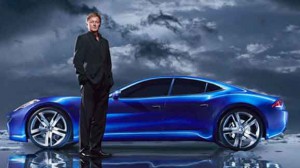 The Danish car designer Henrik Fisker tries to rise new funding for his car company in China. The company has not built a car in six months, Reuters news agency tells.
The Danish car designer Henrik Fisker tries to rise new funding for his car company in China. The company has not built a car in six months, Reuters news agency tells.
Top executives at Fisker Automotive Inc, maker of the sleek Karma plug-in hybrid, are scouring Asia – in particular, China – for funding and strategic partners that are viewed as crucial to the automaker’s success, four people familiar with the matter said.
Fisker is courting investors after a tough year marred by the rocky launch of its flagship Karma, the bankruptcy of its battery supplier and an election season that turned the U.S. government-backed company into a political punching bag.
A major driver of Fisker’s China focus is Beijing’s support of local Chinese automakers’ efforts to acquire “green car” technology from abroad. This is part of an effort by the country’s central government to ramp up a market for electric cars and plug-in hybrids in China before the end of this decade.
So far, Fisker has held talks with China Grand Automotive Services Co, a large dealership group that already has an agreement to distribute Fisker cars in China.
It also has held discussions with Wanxiang Group, a Hangzhou-based major producer of automotive components that last month won an auction for bankrupt U.S. lithium-ion battery maker A123 Systems, Fisker’s primary battery supplier.
The U.S. plug-in hybrid car maker also has established contacts with a few state-owned and closely held indigenous Chinese automakers and is likely to hold talks with them in the coming weeks, according to the sources, who declined to be named because the sensitive nature of the matter.
Fisker spokesman Roger Ormisher declined to say with whom the company has spoken. “Fisker is in advanced talks with a number of potential strategic partners,” he said via email. “We expect some exciting developments in the next few months.”
2012 a challenging year for Fisker
Fisker has one product on the market now, the Karma plug-in hybrid, whose price tag starts at around $103,000. It has a second car in the works, the Atlantic, which is likely to start at about $55,000.
Fisker halted the development of the Atlantic last year after the U.S. Department of Energy barred the automaker from drawing down the remaining portion of its $529 million federal loan. Fisker had spent about $190 million of that loan, which was aimed at spurring alternative energy companies in the United States.
Then Fisker halted production of the Karma last July when A123 had trouble supplying batteries because of quality issues. A123 later filed for bankruptcy and went up for grabs in an auction as part of a court-supervised process.
China has a stated goal to put on the roads a total of 500,000 battery cars – all-electric cars and plug-in electric hybrids – by 2015 and some 5 million by 2020. Meeting those objectives is a test for new Communist Party chief Xi Jinping’s commitment to balance economic growth and energy conservation, which means there is more money available in China for Fisker potentially to harness.
“Unless you have a credible presence in China and establish a way to leverage the scale of that potentially huge demand for green cars, you have no future as an electric-car company,” one of the people said.
The immediate task in front of Fisker is to complete its ongoing effort to raise $150 million to complete the nearly finished development of a second vehicle, and the company had raised about $115 million of it by the end of last year. Some Fisker officials also have pointed to the possibility of Fisker needing additional funds to finish the second vehicle.
Also crucial for the company is the Atlantic, which is expected to generate more volume than the Karma. Fisker is aiming to start production of this model in late 2014 or 2015, according to a presentation it gave Goldman Sachs last year.
Fisker has sold about 2,000 Karma cars since it was launched in late 2011, according to the company.
China will be the world’s biggest luxury car market in 2020
Sources believe China is an essential market for a producer of exotic cars, such as Fisker. While there is little demand at present for electric cars in China, Fisker and other upscale car companies believe they need to build a presence because demand for luxury cars in China is forecast to grow to 2.7 million vehicles a year by 2020, overtaking the United States as the world’s biggest luxury car market.
The problem facing Fisker – founded in part with venture capital funding in 2007 by Henrik Fisker, a former BMW and Aston Martin designer – is mainly two-fold.
It must find a way to restart development of the Atlantic hybrid. Fisker also needs to make sure it has a stable supply of batteries as A123’s future remains uncertain.
Fisker in July hired investment banking firm Evercore Partners, which has expertise in restructuring. However, Fisker’s executives insist that this move was related to the search for new investors and partners, not to explore restructuring through bankruptcy.
Still, few promising leads for new funding or partnerships have emerged in Europe or Asia, the sources said.

